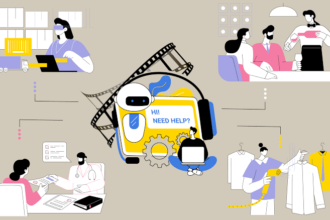Artificial intelligence has transformed how we work, communicate, and solve complex problems. Yet most discussions focus on familiar names like ChatGPT, Claude, or Gemini. But there’s another player quietly making waves in the tech world: Sylveer.
This emerging technology platform represents a significant shift in how we approach AI-driven solutions. While many AI tools focus on single applications like writing or image generation, Sylveer takes a different approach entirely. It’s designed as a comprehensive ecosystem that integrates multiple AI capabilities into one cohesive platform.
Understanding Sylveer matters because it signals where the industry might be heading next. As businesses and individuals seek more integrated, efficient AI solutions, platforms like this could reshape our digital landscape. This post will explore what makes Sylveer unique, its potential applications, and why it deserves your attention.
What Makes Sylveer Different
A Unified Approach to AI
Most AI platforms excel in specific areas. Some handle text generation beautifully, others process images with stunning accuracy, and still others manage data analysis efficiently. Sylveer breaks down these silos by combining multiple AI functions within a single interface.
Users can switch seamlessly between different AI capabilities without jumping between platforms or learning new interfaces. This integration reduces friction and creates opportunities for more complex, multi-step workflows that previously required multiple tools.
Focus on Contextual Understanding
Sylveer’s architecture emphasizes maintaining context across different types of tasks. When you’re working on a project that involves text, images, and data analysis, the platform remembers what you’ve done previously and applies that knowledge to subsequent tasks.
This contextual awareness enables more sophisticated problem-solving. Instead of treating each AI interaction as isolated, Sylveer builds understanding over time, leading to more relevant and useful outputs.
Customizable Workflows
Rather than forcing users into predetermined patterns, Sylveer allows for significant customization. Organizations can design workflows that match their specific needs, creating chains of AI-powered actions that automate complex processes.
This flexibility makes it particularly appealing to businesses with unique requirements that don’t fit neatly into existing AI tool categories.
Key Applications and Use Cases
Content Creation and Marketing
Marketing teams are finding Sylveer particularly useful for comprehensive campaign development. The platform can generate initial copy concepts, create supporting visuals, analyze market data, and even suggest optimization strategies—all within the same workspace.
This integrated approach means fewer handoffs between team members and tools, leading to faster campaign development and better consistency across different content types.
Research and Analysis
Researchers appreciate Sylveer’s ability to handle multiple data types simultaneously. The platform can process written documents, analyze numerical data, and even interpret visual information to provide comprehensive insights.
Academic institutions and research organizations are beginning to explore how this integrated approach might accelerate discovery and improve research quality.
Business Process Automation
Companies are using Sylveer to automate complex business processes that previously required human oversight at multiple stages. The platform’s ability to understand context and maintain continuity across different task types makes it suitable for end-to-end process automation.
From customer service workflows to financial analysis pipelines, organizations are finding applications across various departments.
Technical Architecture and Innovation
Multi-Modal Processing
Sylveer’s technical foundation supports true multi-modal processing. This means the platform doesn’t just handle different types of input separately—it actually processes text, images, audio, and structured data together to create richer understanding.
This capability enables applications that weren’t practical with single-modal AI systems. For example, analyzing customer feedback that includes written comments, uploaded images, and numerical ratings all at once.
Scalable Infrastructure
The platform is built with scalability in mind, using cloud-native architecture that can adapt to varying workloads. This design choice makes it suitable for both individual users and large enterprises with demanding requirements.
Privacy and Security Considerations
Sylveer implements several privacy-focused features, including options for on-premises deployment and data isolation. These capabilities address growing concerns about AI systems handling sensitive information.
Market Position and Competition
Competitive Landscape
Sylveer enters a market dominated by specialized AI tools and large tech companies with comprehensive AI offerings. Its positioning as an integrated platform puts it in direct competition with both category leaders and emerging competitors.
The success of this approach will likely depend on execution quality and the platform’s ability to match or exceed the performance of specialized tools in their respective areas.
Adoption Patterns
Early adoption appears strongest among organizations that previously relied on multiple AI tools and sought greater integration. These users value the reduced complexity and improved workflow efficiency that Sylveer promises.
Individual users seem more cautious, often preferring familiar tools for specific tasks rather than learning a new comprehensive platform.
Challenges and Limitations
Learning Curve
Despite its integrated design, Sylveer requires users to understand a more complex system than single-purpose AI tools. This learning curve may slow adoption, particularly among users who only need occasional AI assistance.
Performance Trade-offs
Creating a platform that handles multiple AI capabilities well is technically challenging. There’s always a risk that integrated solutions sacrifice some performance compared to specialized tools optimized for specific tasks.
Early user feedback suggests Sylveer performs competitively in most areas, though some specialized use cases still benefit from dedicated tools.
Market Education
As a newer entrant, Sylveer faces the challenge of educating potential users about the benefits of integrated AI platforms. Many users are comfortable with their current toolkit and may not immediately see the value in switching.
Looking Ahead: The Future of Integrated AI
Industry Trends
The emergence of platforms like Sylveer reflects broader industry trends toward integration and consolidation. As AI capabilities mature, users increasingly want comprehensive solutions rather than collections of separate tools.
This trend mirrors what happened in other software categories, where integrated suites eventually competed successfully against best-of-breed point solutions.
Potential Impact
If successful, Sylveer and similar platforms could significantly change how organizations approach AI adoption. Instead of evaluating and implementing multiple AI tools, they might focus on choosing comprehensive platforms that handle most of their needs.
This shift could also influence how AI capabilities develop, with more emphasis on integration and workflow optimization rather than pure performance in isolated tasks.
Making Sense of the Sylveer Revolution
Sylveer represents more than just another AI platform—it embodies a vision of how artificial intelligence might evolve beyond today’s fragmented tool landscape. Its integrated approach addresses real pain points that organizations face when trying to implement AI across multiple functions and workflows.
Whether Sylveer succeeds in establishing this new category depends on several factors: technical execution, market timing, and users’ willingness to embrace more comprehensive AI solutions. The early signs are promising, with growing interest from organizations seeking to simplify their AI toolkit.
For anyone involved in AI adoption decisions, Sylveer deserves serious consideration. Even if you ultimately choose different solutions, understanding this integrated approach will help you better evaluate the evolving AI landscape and make more informed technology choices.
The technology revolution Sylveer represents isn’t just about one platform—it’s about the future direction of AI development and deployment. That alone makes it worth knowing about.

















